
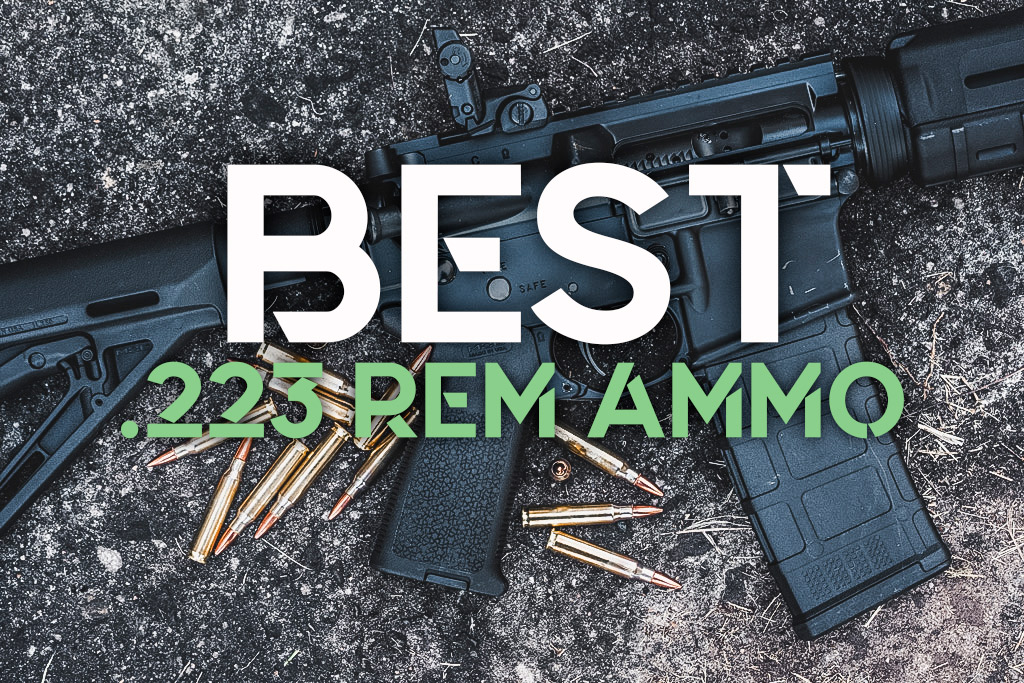
The .223 Remington and its nearly identical twin brother, the 5.56x45mm NATO, need very little introduction. They represent one of the most common calibers in the U.S. Being the NATO standard, they are in use in various platforms around the world. The data to list the number of world-wide .223 users is surprisingly difficult to find. So what is the best 223 ammo?
Anyone who recalls the 2012 ammunition crisis can attest to the serious shortages of .223 ammunition on the market. Yes, there was a time when almost all ammunition was selling out instantly. Anything vaguely associated with the AR-pattern rifle was nowhere in sight. Let’s take a look at the reasons for the popularity of the AR-rifle platform, and find the best .223 ammo for practical use applications.
Best 223 Ammo: Plinking & Training
Are you planning to engage cardboard targets at 25 yards? Are you ready to get dirty and train like you fight? You don’t need to shell out the dough on the higher-priced stuff. Go with the stuff that goes ‘bang’ every time you pull the trigger and doesn’t require you to take out a personal loan.
PMC 223 Rem 55 Grain FMJ
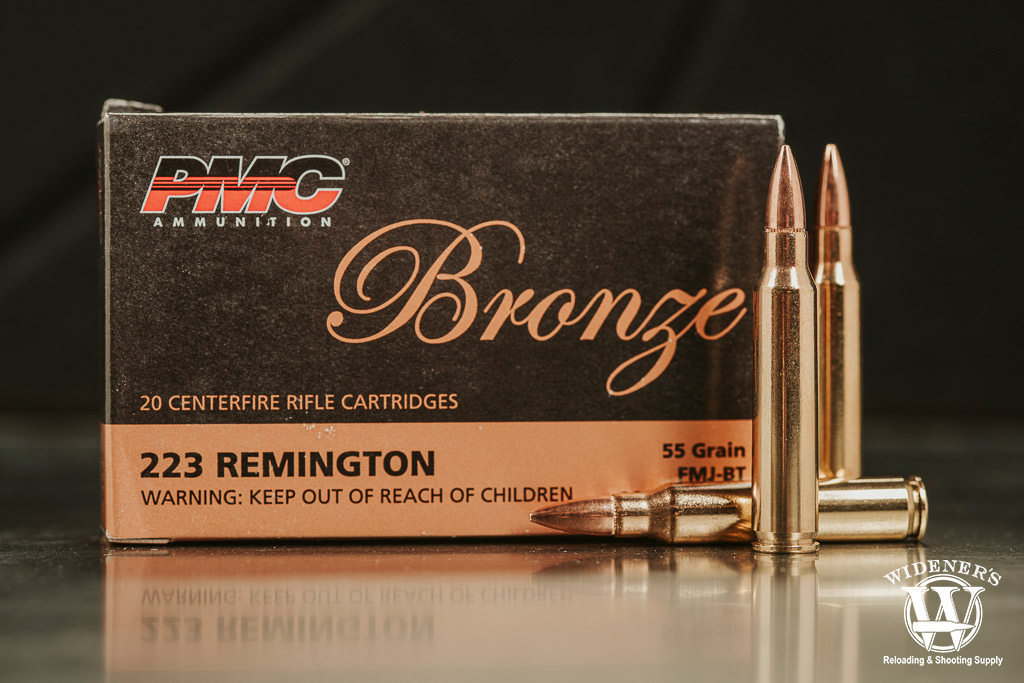
It’s affordable, it goes bang, and it lives up to its name, PMC is precision-made cartridges.
Ask any professional competitor what ammo brand they practice with, and they’ll reply, “PMC.” It’s cheap, it’s more than accurate enough, and it shoots cleaner than other budget options. A case of PMC 223 Rem 55gr will keep you at the range longer, for less coin, with less time invested in cleaning your rifle afterward.
The 55gr FMJ bullet design offers solid performance for the price point. The cartridge has a muzzle velocity of 3,200 FPS and a muzzle energy of 1,250 foot-pounds. If you’ve got plinking and training on your range schedule, this one’s a no-brainer.
| Caliber | Bullet Type | Bullet Weight | Velocity (Muzzle) | Energy (Muzzle) | 100 Yards (Velocity/Energy) | 200 Yards (Velocity/Energy) | 300 Yards (Velocity/Energy) |
|---|---|---|---|---|---|---|---|
| .223 Rem | FMJ | 55gr | 3,200 FPS | 1,250 FT LBS | 2,833 FPS/980 FT LBS | 2,493 FPS/759 FT LBS | 2,180 FPS/580 FT LBS |
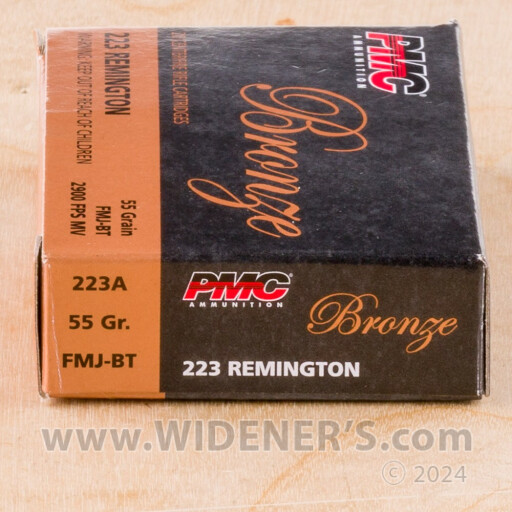
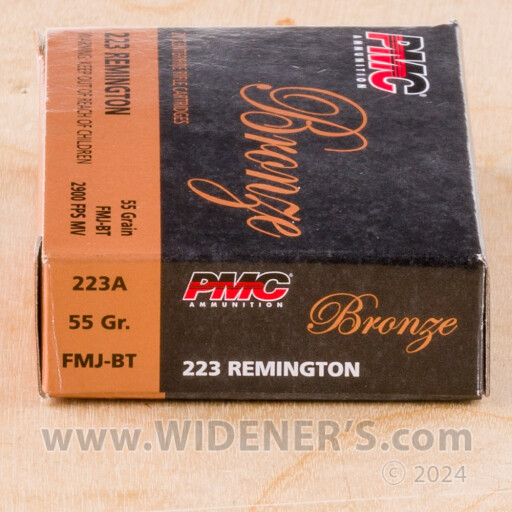
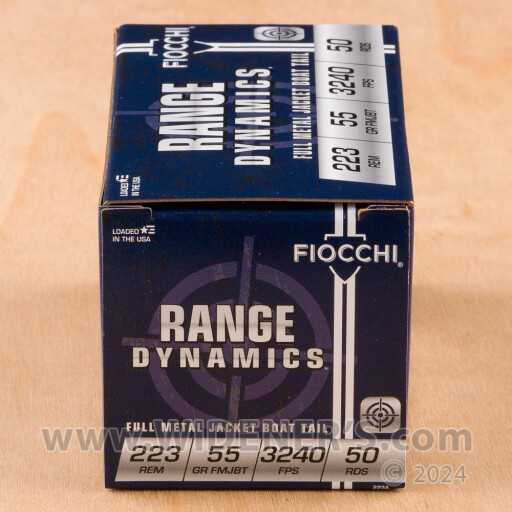
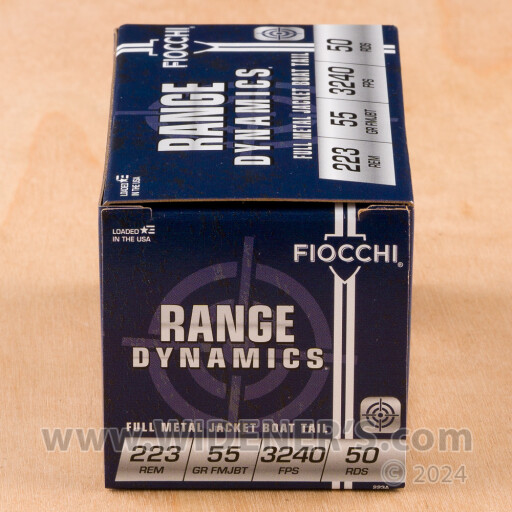
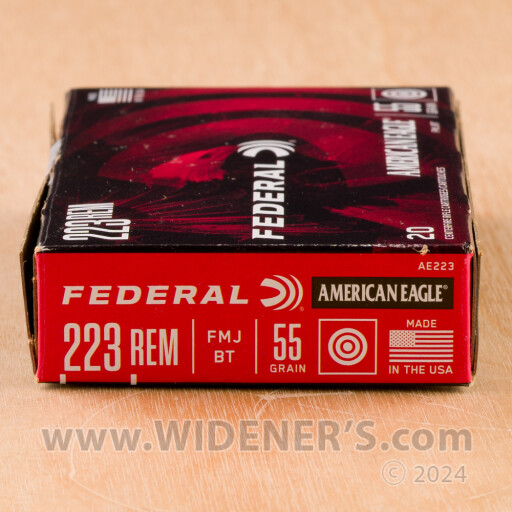
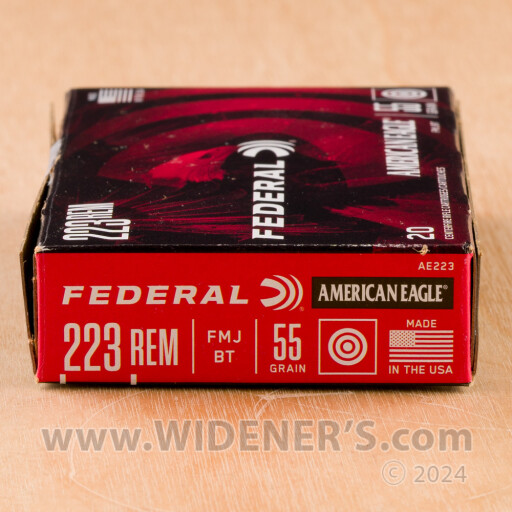
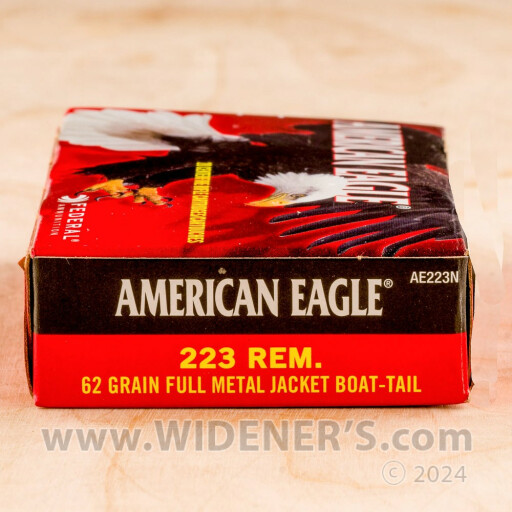
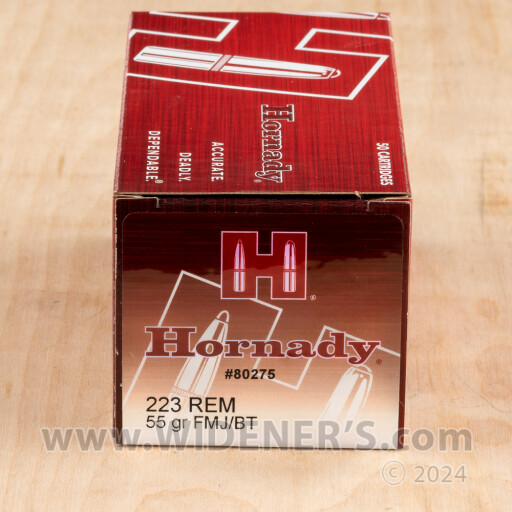
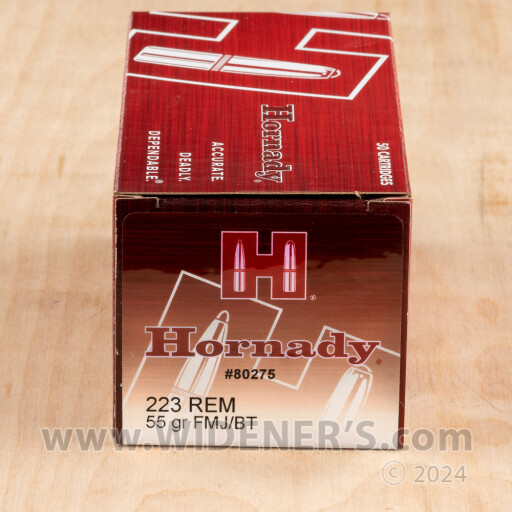

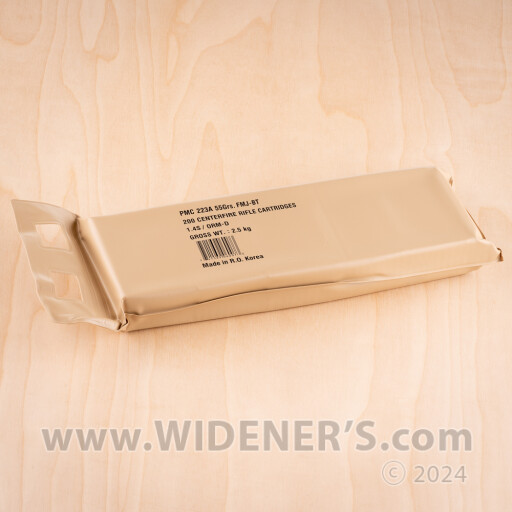
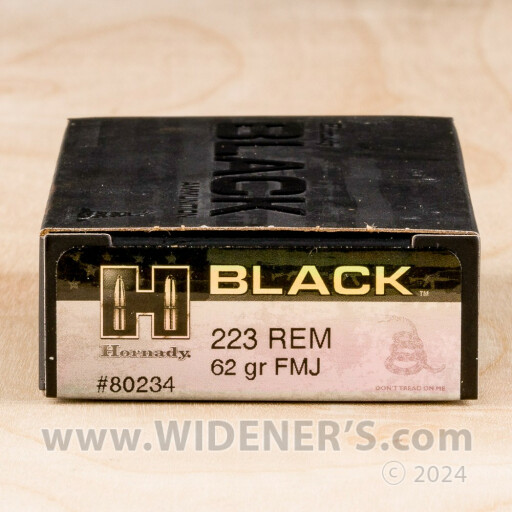
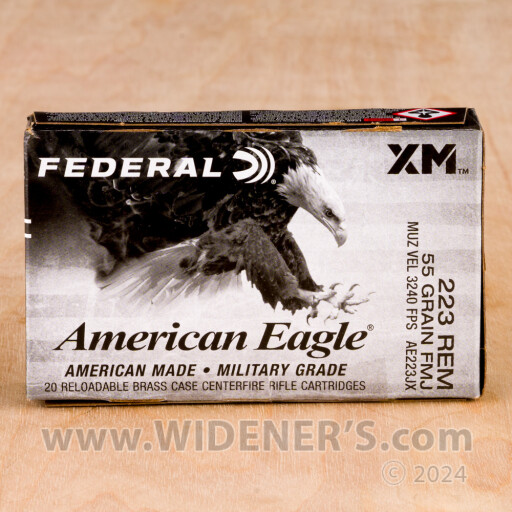


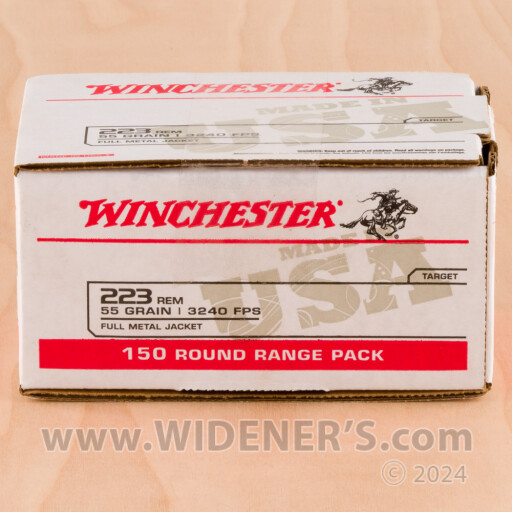



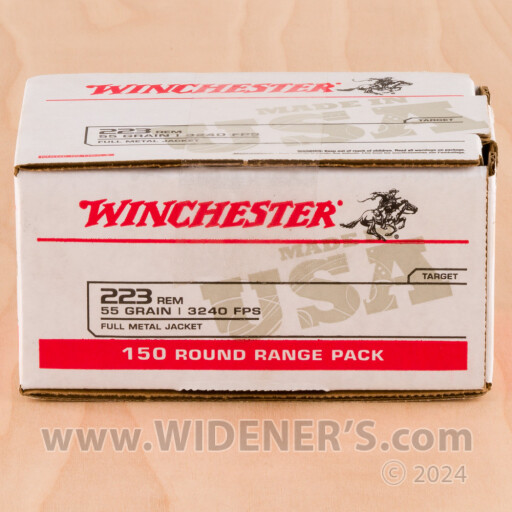
Federal American Eagle 223 Rem 55 Grain FMJ
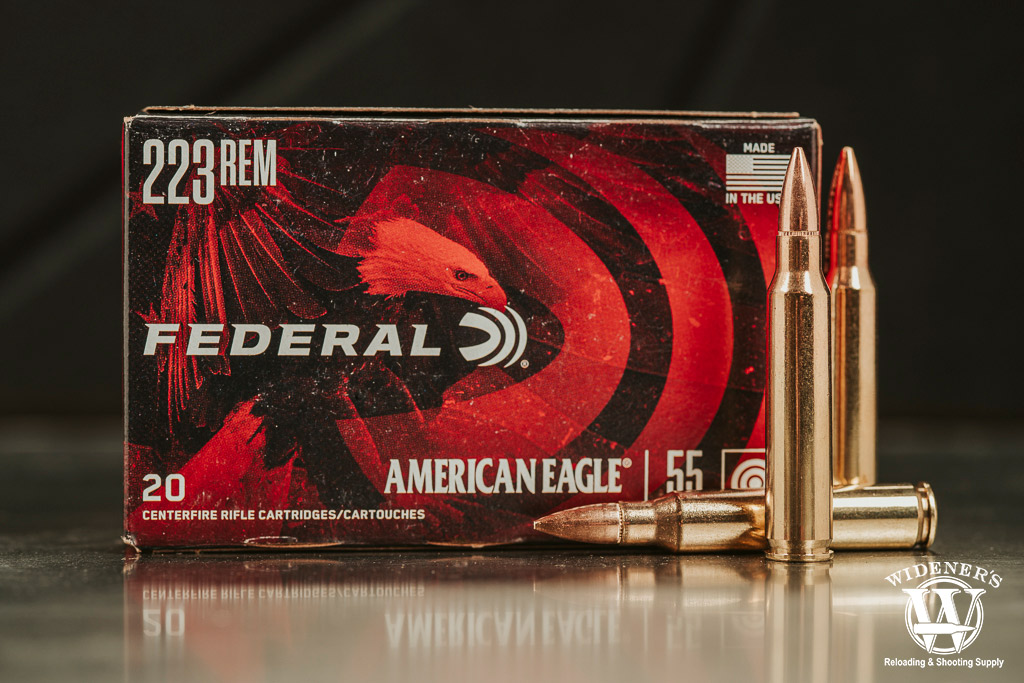
Fly like an eagle with Federal American Eagle ammo, it won’t weigh your wallet down at the gun range.
Don’t let the price point fool you. Federal American Eagle ammo is affordable, accurate, and most importantly, reliable. It’s ideal for target practice, while you’re sighting in your weapon, or running training drills. It’s loaded at the Federal plant in Anoka, MN using all-new brass, and quality primers. I’ve been there, and I can tell you firsthand, that even the bulk ammo gets a thorough inspection on their assembly line.
It does exactly what range ammo needs to do, plus a little more. The engineers at Federal streamlined the bullet design to give you a muzzle velocity of 3,240 FPS and a muzzle energy of 1,282 foot-pounds. That’s a lot of bang for your hard-earned buck.
| Caliber | Bullet Type | Bullet Weight | Velocity (Muzzle) | Energy (Muzzle) | 100 Yards (Velocity/Energy) | 200 Yards (Velocity/Energy) | 300 Yards (Velocity/Energy) |
|---|---|---|---|---|---|---|---|
| .223 Rem | FMJ | 55gr | 3,240 FPS | 1,282 FT LBS | 2,874 FPS/1,008 FT LBS | 2,536 FPS/785 FT LBS | 2,222 FPS/603 FT LBS |








Best 223 Ammo: Competition & Match
Federal Premium Sierra MatchKing Gold Medal 223 Rem 69 Grain HPBT
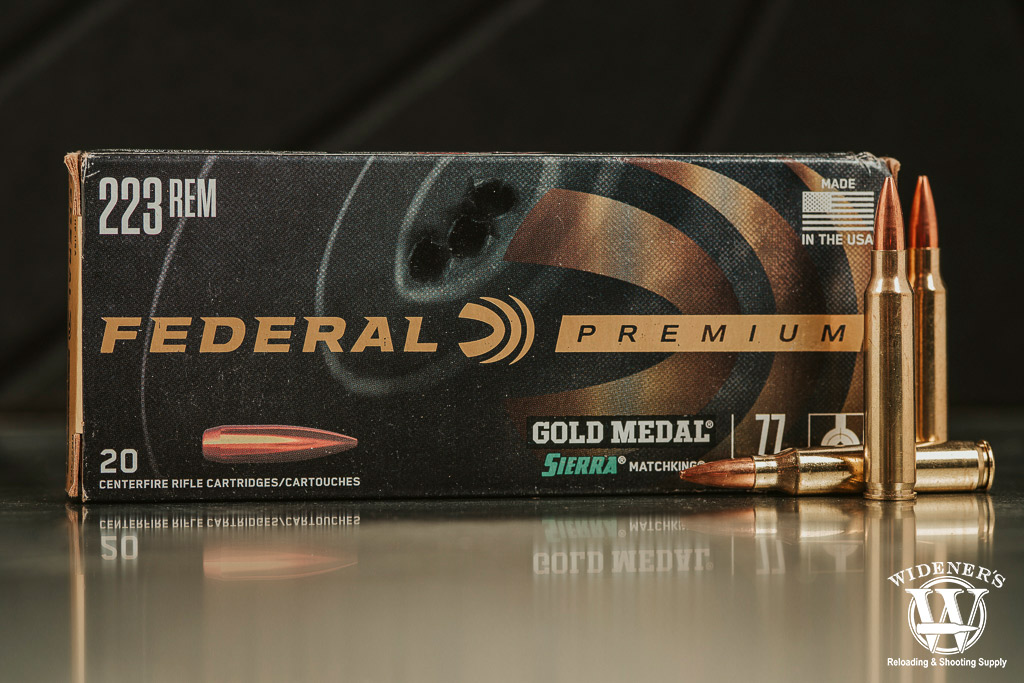
Federal Gold Medal Match ammo provides an excellent ballistic coefficient for shooters to work with.
Ideally suited for barrels with a lower twist rate, like the 1:7 and 1:8. The heavy 69gr Federal Gold Match is tailored for competition shooting. If you need to go heavier for stability at greater distances, check out the excellent 77gr version.
The Sierra MatchKing is a boat-tail design, which is synonymous with excellent aerodynamics. It yields a ballistic coefficient of 0.301 at a muzzle velocity of 2,950 fps. The heavier weight resists the effects of wind better than lighter bullets. It also creates a longer, sleeker bullet in the process.
| Caliber | Bullet Type | Bullet Weight | Velocity (Muzzle) | Energy (Muzzle) | 100 Yards (Velocity/Energy) | 200 Yards (Velocity/Energy) | 300 Yards (Velocity/Energy) |
|---|---|---|---|---|---|---|---|
| .223 Rem | HP | 69gr | 2,950 FPS | 1,333 FT LBS | 2,642 FPS/1,069 FT LBS | 2,353 FPS/848 FT LBS | 2,084 FPS/665 FT LBS |
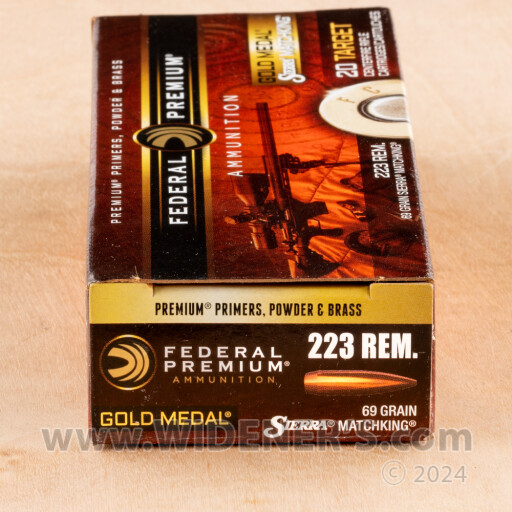
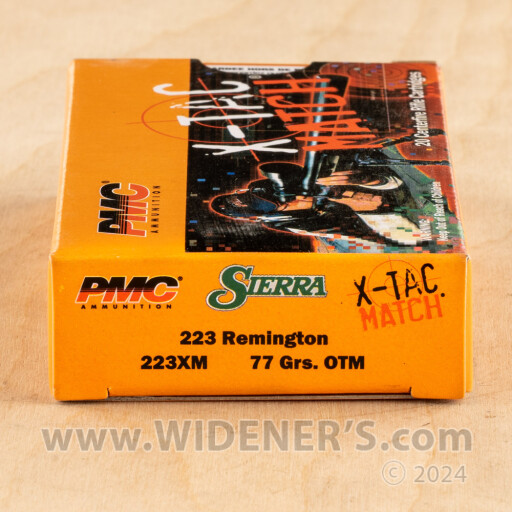

Hornady Superformance Match 223 Rem 75 Grain HPBT
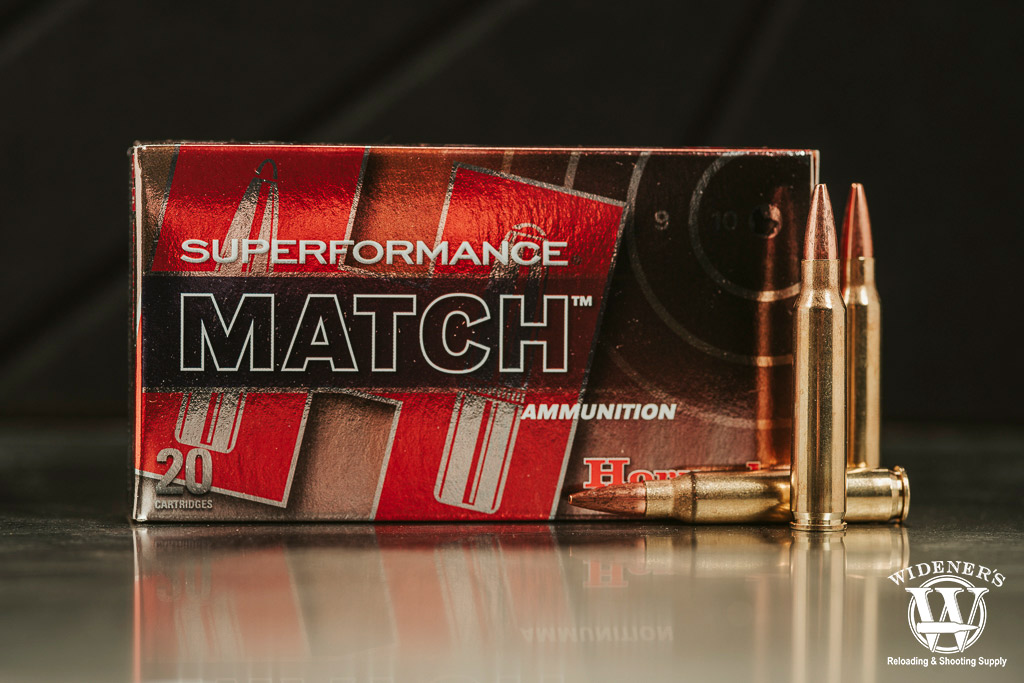
Superformance Match ammo from Hornady has the performance that professionals need for critical situations.
Hornady built its brand around accuracy and performance. That legendary performance lives on in the Superformance Match 75 Grain cartridge. It’s fast, with precision accuracy, and a flatter trajectory. There’s no mystery why you’ll find this round in the range bags of top-level competitive shooters, specialized law enforcement, and military snipers.
The 75gr hollow-point bullet design offers low-drag, high-velocity performance. The cartridge has a muzzle velocity of 2,930 FPS and a muzzle energy of 1,430 foot-pounds. For those counting, that’s 100-200 FPS faster than conventional .223 Rem ammo with a similar grain weight.
| Caliber | Bullet Type | Bullet Weight | Velocity (Muzzle) | Energy (Muzzle) | 100 Yards (Velocity/Energy) | 200 Yards (Velocity/Energy) | 300 Yards (Velocity/Energy) |
|---|---|---|---|---|---|---|---|
| .223 Rem | HP | 75gr | 2,930 FPS | 1,430 FT LBS | 2,695 FPS/1,209 FT LBS | 2,471 FPS/1,017 FT LBS | 2,259 FPS/850 FT LBS |
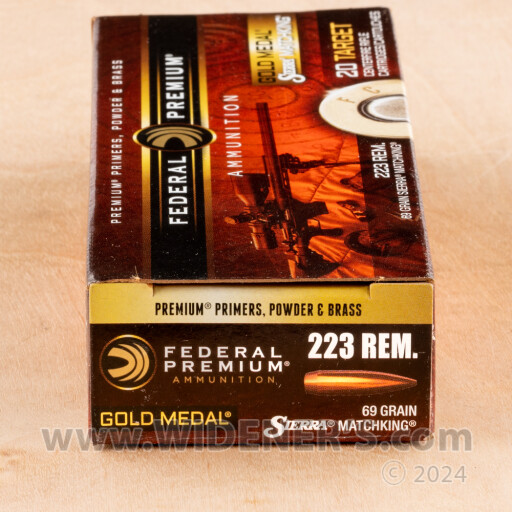


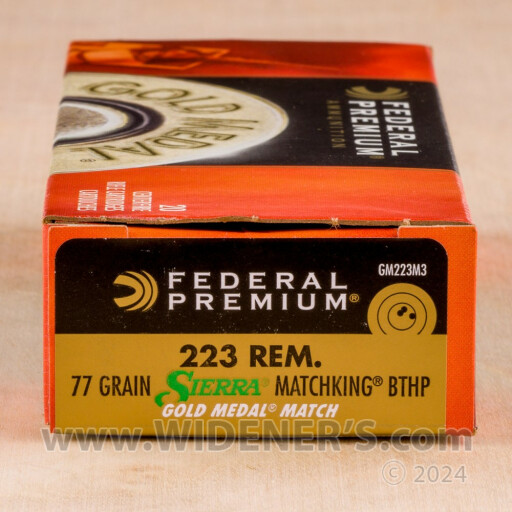
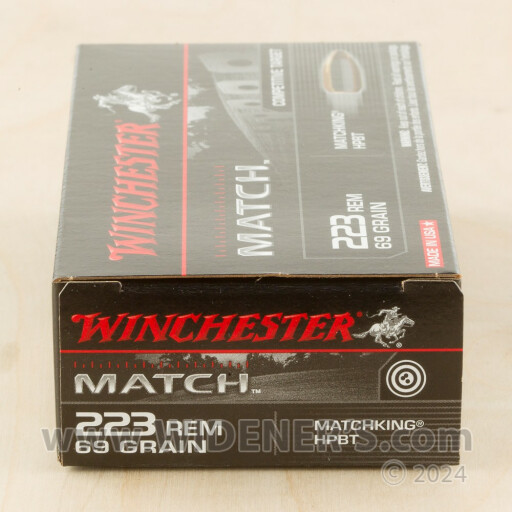
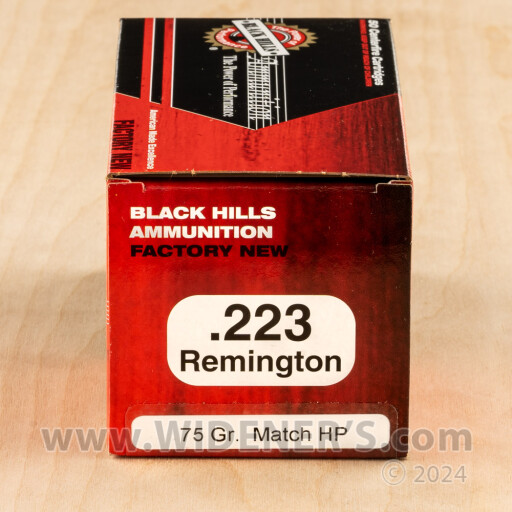

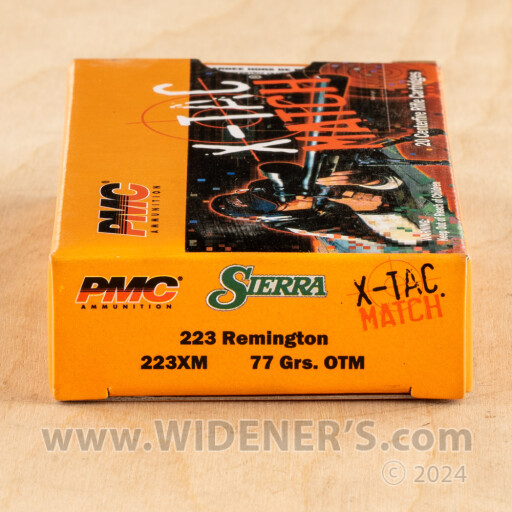
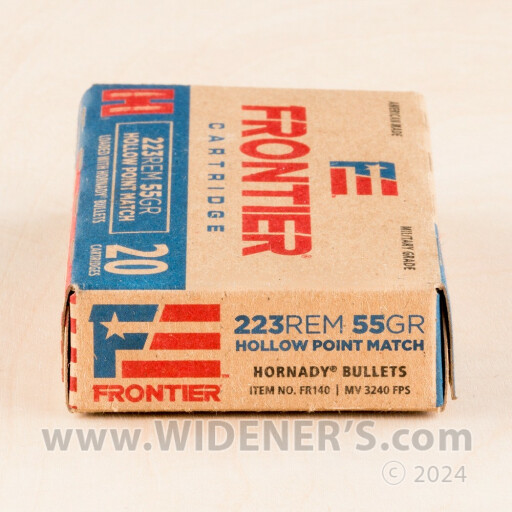
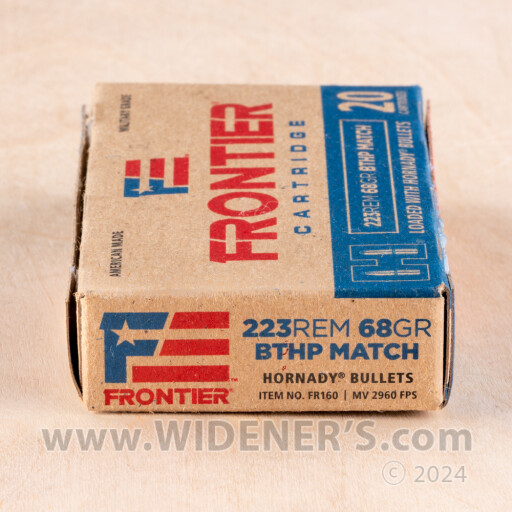
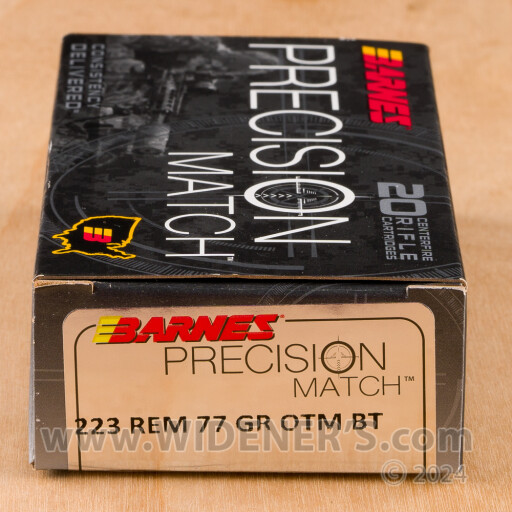
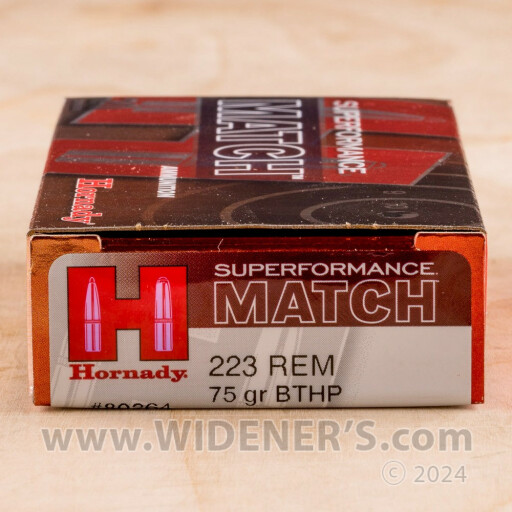
Best 223 Ammo: Home Defense
Expect the unexpected. Have a plan and plan to act. Train like your life depends on it. No matter the situation, these home defense ammo selections will have your six.
Federal LE Tactical TRU 223 Rem 55 Grain SP
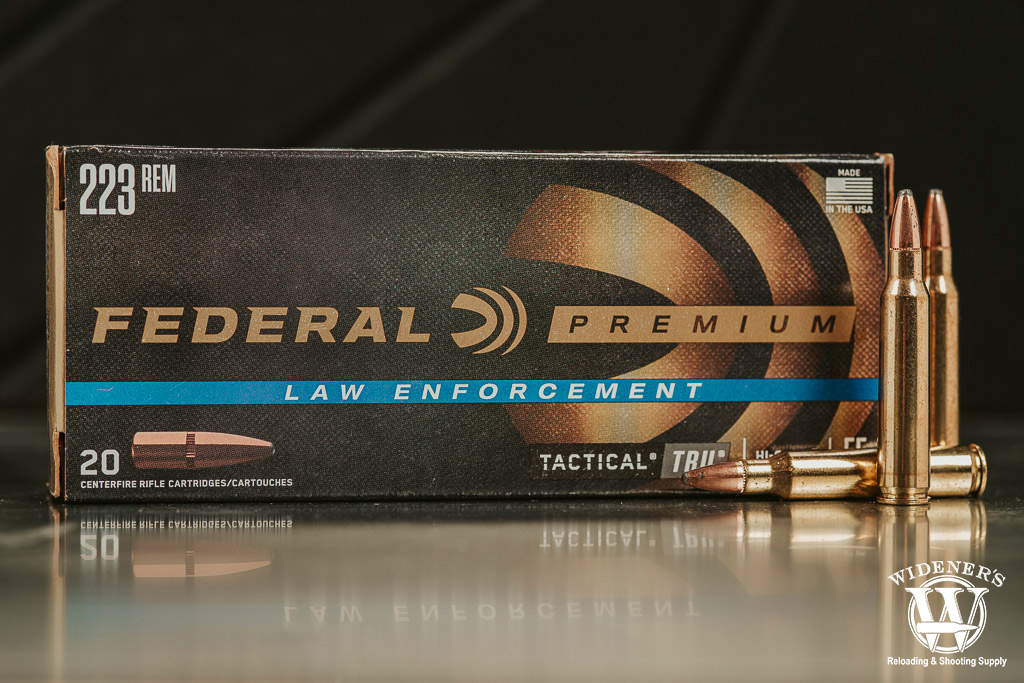
Excellent materials and performance make Federal Premium Law Enforcement ammo a perfect choice for self-defense.
The Federal LE line is a bit of a sleeper in the home defense category. First, it’s specifically designed to be used in AR-pattern MSR rifles. That means it’s been created to run reliably in your magazine-fed home defense gun under high-stress situations. Secondly, the bullet is engineered to dump energy quickly upon impact. For urban environments, that means less probability of over-penetration.
Federal makes several versions of this round, with different bullet types, and grain weights to suit your needs. That being said, this isn’t a round that’s intended to have an impressive ballistic coefficient at distances. It’s for CQB when things get down and dirty. Expect a muzzle velocity of 3,220 FPS and a muzzle energy of 1,266 foot-pounds from the 55gr SP cartridge.
| Caliber | Bullet Type | Bullet Weight | Velocity (Muzzle) | Energy (Muzzle) | 100 Yards (Velocity/Energy) | 200 Yards (Velocity/Energy) | 300 Yards (Velocity/Energy) |
|---|---|---|---|---|---|---|---|
| .223 Rem | SP | 55gr | 3,220 FPS | 1,266 FT LBS | 2,829 FPS/977 FT LBS | 2,470 FPS/745 FT LBS | 2,138 FPS/558 FT LBS |

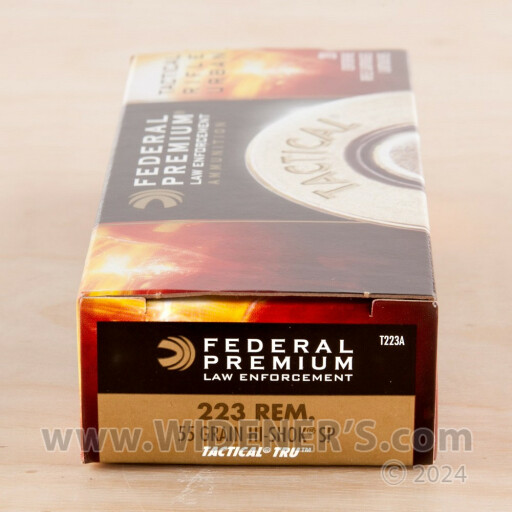

Hornady Critical Defense 223 Rem 55 Grain Hornady FTX
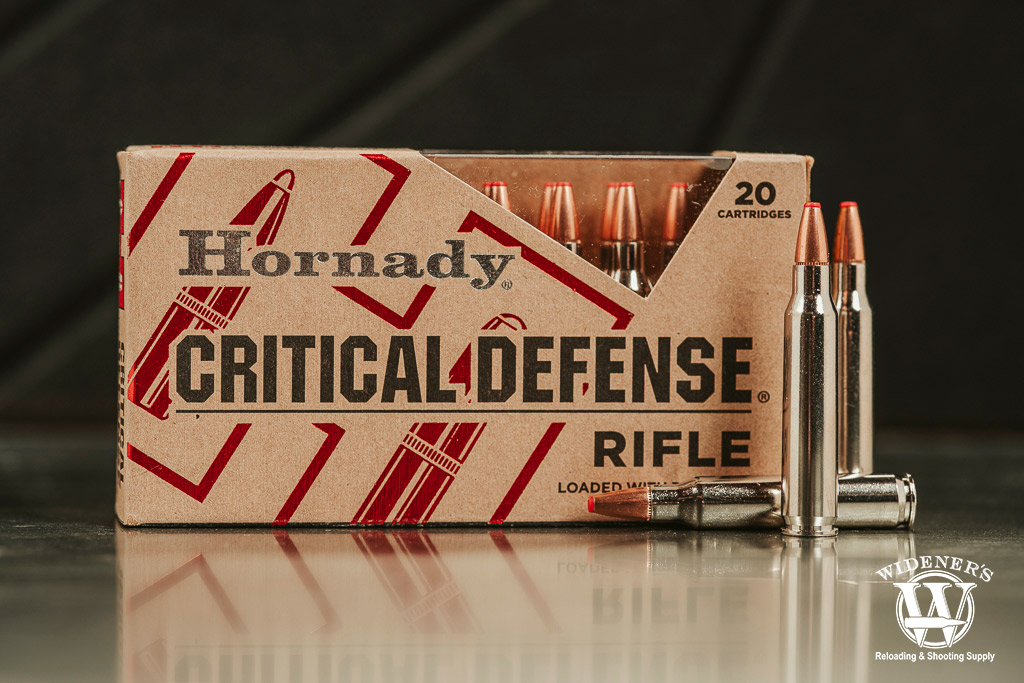
Designed for short-range defensive conditions, FTX bullets are at the forefront of Hornady’s Critical Defense Rifle line.
Wait, are you telling me that Hornady makes a .223 Rem round with an FTX bullet? Yes, yes I am. If you carry Hornady Critical Defense FTX ammo in your concealed carry gun, you already know what I’m about to tell you. FTX bullets have a polymer center tip that keeps the nose cavity from clogging as it passes through layers of fabric. In self-defense situations, this enables the round to rapidly expand (as designed) when making contact with unannounced soft targets.
Nickle-plated brass casings ensure smooth feeding in your rifle when things go bump in the night. The case plating also resists corrosion, from environmental factors, like loading your magazines after a late-night trip to Taco Bell. The cartridge has a muzzle velocity of 3,240 FPS and a muzzle energy of 1,282 foot-pounds.
| Caliber | Bullet Type | Bullet Weight | Velocity (Muzzle) | Energy (Muzzle) | 100 Yards (Velocity/Energy) | 200 Yards (Velocity/Energy) | 300 Yards (Velocity/Energy) |
|---|---|---|---|---|---|---|---|
| .223 Rem | FTX | 55gr | 3,240 FPS | 1,282 FT LBS | 2,690 FPS/883 FT LBS | 2,201 FPS/592 FT LBS | 1,768 FPS/382 FT LBS |


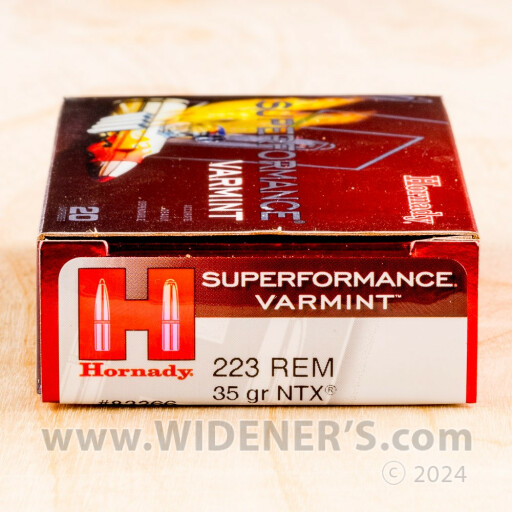





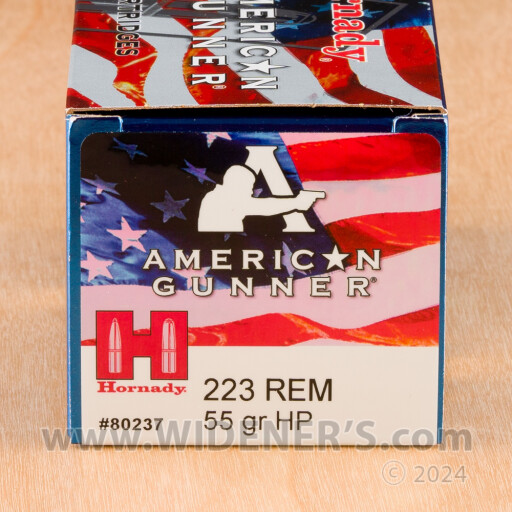
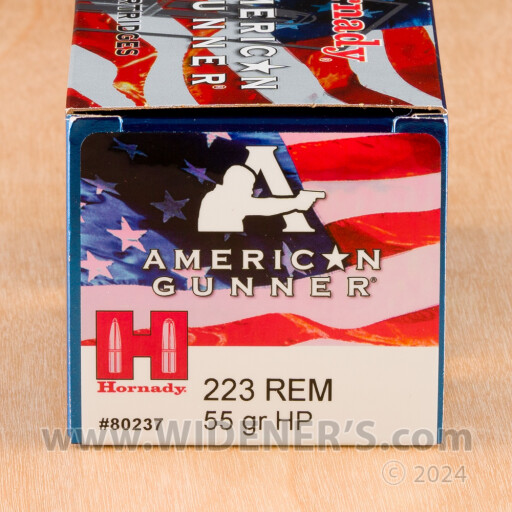

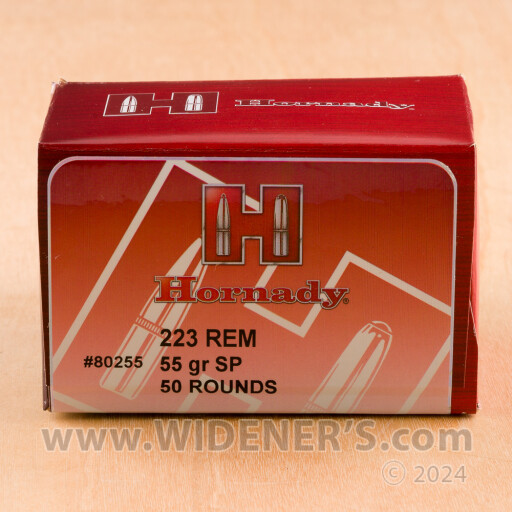
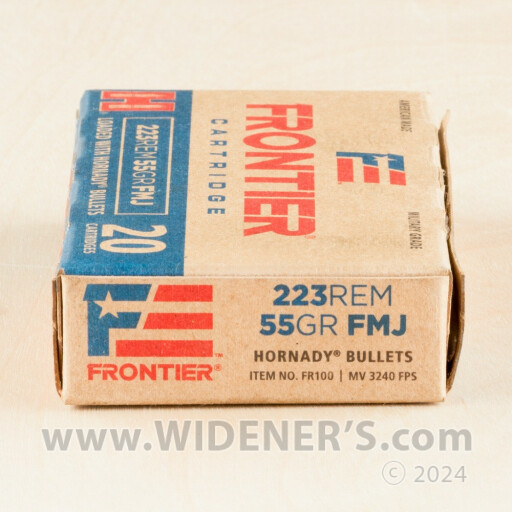
Best 223 Ammo: Varmint
There are few things worse than waking up in the middle of the night to hear a critter rustling your chicken coop. Or, if you have livestock, you know all too well the cries of coyotes in the distance as the sun goes down. These recommendations are for taking care of uninvited critters, and pesky varmints.
If you’re having critter problems, I feel bad for you, son. I’ve got ninety-nine problems, but a varmint ain’t one.” -Jay-Z, varmint hunting, probably.
Winchester Varmint-X 223 Rem 40 Grain PT
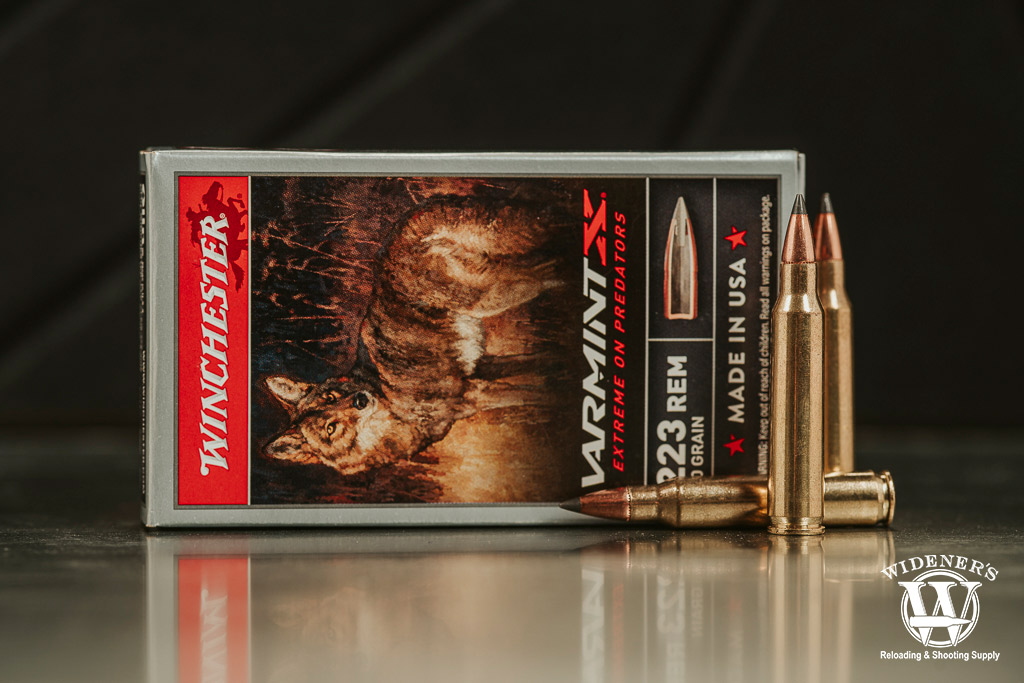
Winchester’s Varmint X is designed specifically for the demands of predator and varmint hunters.
There are plenty of varmint-specific .223 cartridges available on the market. So, why did this one make my list? I’ll do my best to explain it without triggering a lengthy disclaimer from our legal department. Let’s say, hypothetically, that a coyote got into your livestock pen. He’s acting kind of funny, and there’s a chance he may be rabid. You could be diplomatic, and politely ask him to leave. Or, you could ensure that you know your target, and what’s beyond, and send him an explosive 40gr round to the dome from a safe distance.
If that “hypothetical” varmint scenario sounds familiar to you, as it does to me, this is the cartridge I’d recommend. That’s all I’m saying. Expect a muzzle velocity of 3,600 FPS and a muzzle energy of 1,151 foot-pounds from this fragmenting 40r cartridge.
| Caliber | Bullet Type | Bullet Weight | Velocity (Muzzle) | Energy (Muzzle) | 100 Yards (Velocity/Energy) | 200 Yards (Velocity/Energy) | 300 Yards (Velocity/Energy) |
|---|---|---|---|---|---|---|---|
| .223 Rem | PT | 40gr | 3,600 FPS | 1,151 FT LBS | 3,073 FPS/839 FT LBS | 2,605 FPS/602 FT LBS | 2,181 FPS/423 FT LBS |




Best 223 Ammo: Deer Hunting
We didn’t start the .223 deer hunting debate, but we hope sharing our knowledge will help you make educated ammo decisions. You’ll be able to ethically harvest a deer this season, and put meat on the table with good shot placement. If you live in a state where .223 Rem is prohibited for deer hunting, check out our best .350 Legend ammo article instead.
Federal Fusion 223 Rem Ammo 62 Grain SP
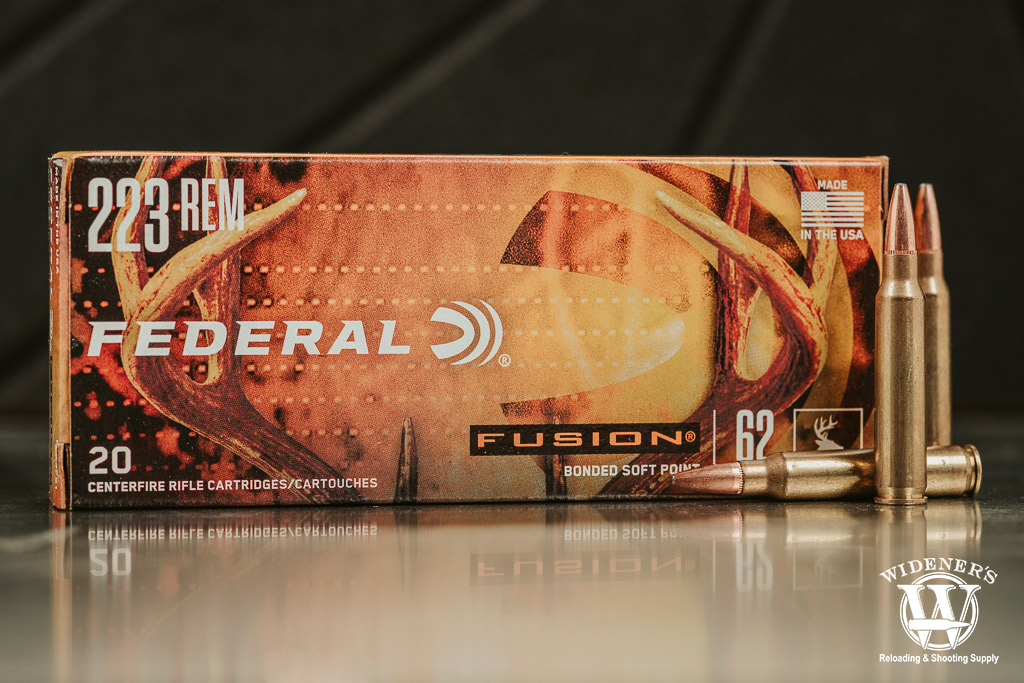
Federal Fusion was the first rifle ammunition specifically built for deer hunting—and it’s still one of the most respected.
Asking a man what hunting ammo he uses can be as personal as asking where his favorite fishing spot is. If you’re a good friend, he might think enough of you to share the wealth. Otherwise, you might end up in the WMA backwoods hunting snipes with a slingshot. Thankfully, we’re happy to share our secrets of deer hunting success with you. One of those secrets is Federal Fusion ammo.
Fusion is the keyword with this ammo. Federal fuses the bullet’s copper jacket to its lead core using an electrochemical process. It’s high-tech redneck technology if you know what I mean. Keep in mind, there is an MSR version of Fusion as well, if you plan to hunt deer with your AR-15. The 62gr cartridge has a muzzle velocity of 3,000 FPS and a muzzle energy of 1,239 foot-pounds.
| Caliber | Bullet Type | Bullet Weight | Velocity (Muzzle) | Energy (Muzzle) | 100 Yards (Velocity/Energy) | 200 Yards (Velocity/Energy) | 300 Yards (Velocity/Energy) |
|---|---|---|---|---|---|---|---|
| .223 Rem | SP | 62gr | 3,000 FPS | 1,239 FT LBS | 2,697 FPS/1,001 FT LBS | 2,413 FPS/802 FT LBS | 2,148 FPS/635 FT LBS |
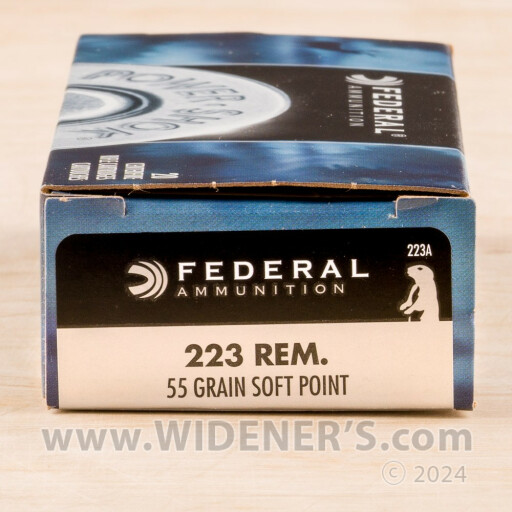
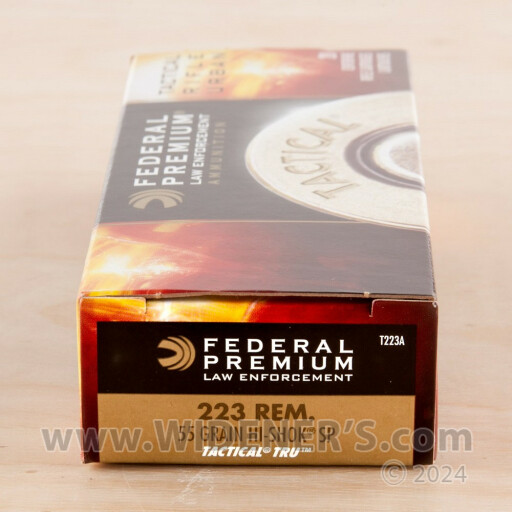


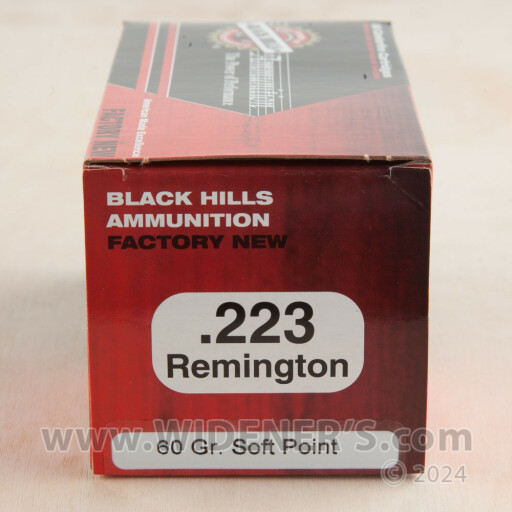
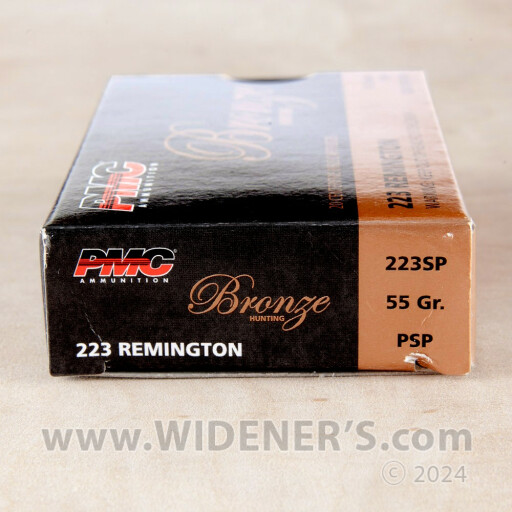
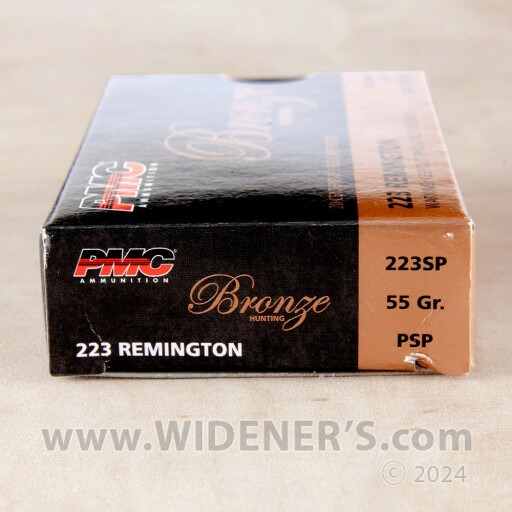



Winchester X223DS Deer Season Extreme Point 64 Grain XP
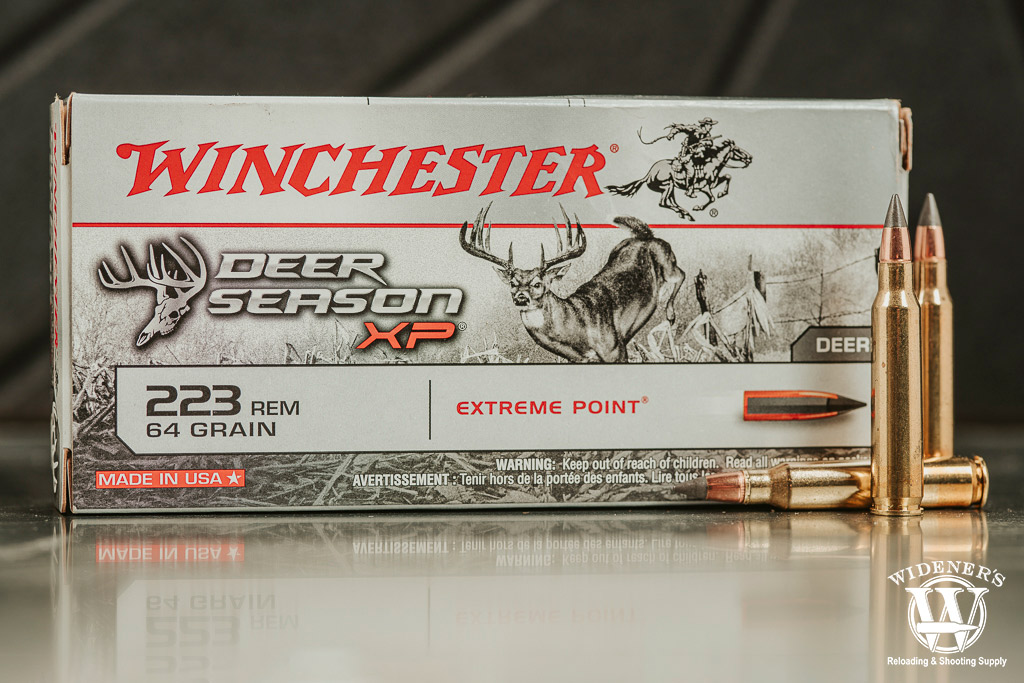
Deer Season XP ammunition combines Winchester’s experience into a product engineered specifically for deer hunters.
If you’re tired of hearing the same old story about the buck your unemployed brother-in-law tagged last season, get out there and do something about it. Wipe that smile off his face with a deep-freezer-worthy buck of your own using Winchester’s Deer Season XP ammo. This specialized hunting bullet creates an oversized impact diameter, leading to a larger wound cavity, with devastating energy transfer.
If you’re deer hunting with .223, don’t spook your target, and remember, shot placement is key. That being said, Winchester’s Deer Season XP in .223 Rem has a sweet spot between 100-200 yards. Expect full penetration with consistent exit wounds in that range. The 64gr cartridge has a muzzle velocity of 3,020 FPS and a muzzle energy of 1,296 foot-pounds.
| Caliber | Bullet Type | Bullet Weight | Velocity (Muzzle) | Energy (Muzzle) | 100 Yards (Velocity/Energy) | 200 Yards (Velocity/Energy) | 300 Yards (Velocity/Energy) |
|---|---|---|---|---|---|---|---|
| .223 Rem | Poly | 64gr | 3,020 FPS | 1,296 FT LBS | 2,693 FPS/1,030 FT LBS | 2,387 FPS/810 FT LBS | 2,103 FPS/628 FT LBS |








Cartridge Specs & Overview
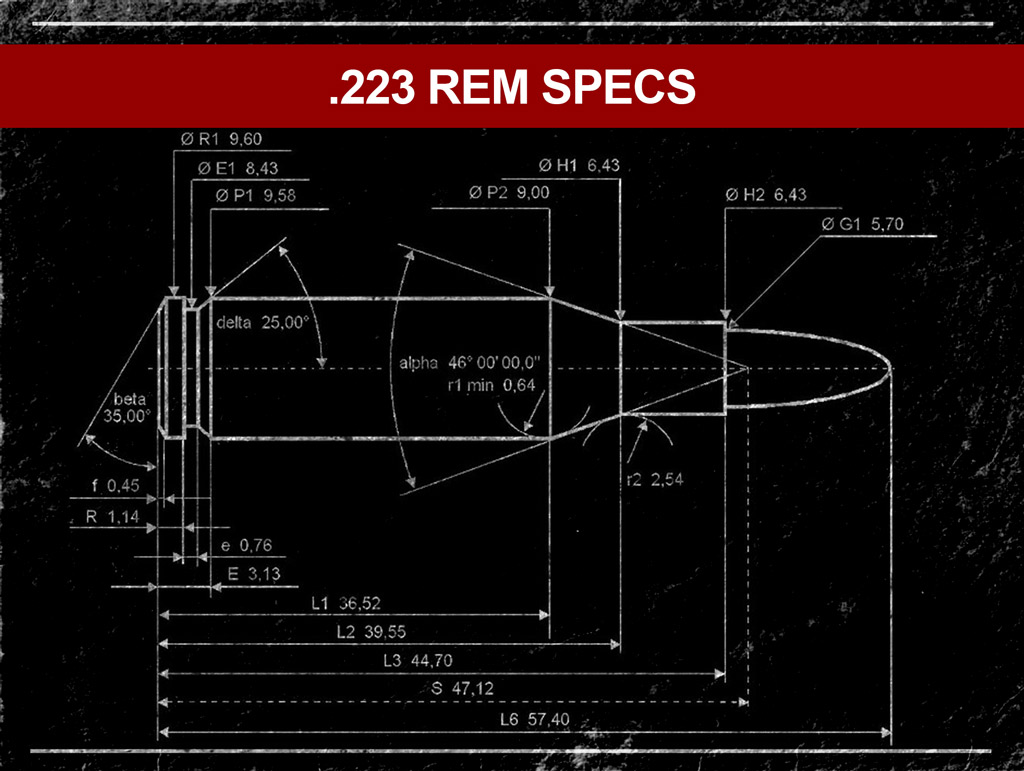
The .223 Rem is a widely used centerfire rifle cartridge for many applications.
The .223, similar to the 5.56x45mm NATO, is a centerfire cartridge developed in the mid-20th century. It’s a step up in power and performance compared to rimfire cartridges. The “.223” in the name denotes the bullet’s diameter in inches (which is actually .224 inches), and with the exception of cartridge pressure it shares many attributes with the 5.56 NATO round. This caliber is prevalent in both military and civilian rifles, including the AR-15 platform, and is suitable for varmint hunting, target shooting, and even some competitive shooting events. With bullet weights ranging from 36 to 77 grains, it can achieve velocities up to around 3,750 FPS.
| Cartridge Specs | .223 Rem |
|---|---|
| Parent Casing | .222 Rem |
| Bullet Diameter | .224″ |
| Neck Diameter | .253″ |
| Base Diameter | .376″ |
| Case Length | 1.76″ |
| Overall Length | 2.26″ |
| Grain Weight | 36gr-77gr |
| Max Pressure (SAMMI) | 55,000 PSI |
Bullet Types & Weights
Full Metal Jacket (FMJ)
The FMJ is the most common type of ammunition. It possesses relative ease of manufacturing and significantly lower materials cost than other types of bullets. By looking at popular ammo-type listings, we can easily see that FMJ rounds are the top 10 selling cartridges. Well, except for the .22 LRN. They mostly serve the same purpose. It is the least expensive cartridge to manufacture and acquire. Ideally, suited for target practice. The standard weights of FMJ target ammo in .223/5.56 are 55 and 62 grain, which are significant.
The lighter grain bullets best pair with higher rates of barrel twist like 1:8 and 1:9. The lowest common twist rate is 1:7, which also happens to be the M4 and M16-A2/A4 standard. Its most common use is with the heavier 62gr. M855 ‘green tip’ cartridge.
Hollow Points (HP)
The hollow point bullet is synonymous with personal and home defense scenarios. Unless you are planning on buying bulk steel-cased Russian ammo, these rounds are at the upper end of the price sheet. The unique manufacturing process for hollow-point bullets is more involved. This translates directly to the price, and to the availability on the market since demand is lower than that of FMJs.
HP ammo has bullet weights similar to the popular offerings of FMJ bullets. Since there isn’t much mass to remove to make the concave opening on a hollow point bullet, the bullet remains small and light. Displaying similar energy and ballistics to the FMJ.
Soft Points (SP)
Best suited as a hunting cartridge, SPs are still quite a popular choice for AR-15 owners. They offer expansion qualities much better than that of an FMJ. They even have more controlled expansion than a hollow point. The goal is to harvest meat or fur not obliterate it. The beauty of the soft point bullet, is that it is not subject to the drag found in HP ammo. The drag is caused by a cavity in the middle of a bullet. The ballistic coefficient of SP ammo is excellent, particularly in the form of a boat tail.
M855

M855 ammo is easily identified by its green tip, its “armor-piercing” capabilities have been greatly exaggerated by the media.
The infamous ‘green tip’ bullet, which all vets will recall with mixed emotions. A fervor for some, despise from others. The purists stand fast that all service rifles should start with something that says “.30”. There are many reasons that give this bullet reputation. A former tenant of the White House demonized it for being “armor-piercing”. They wanted it banned from citizen ownership as “common sense”.
I hate to break it to the uninformed author of that sentiment, but there is nothing new under the sun about the “armor-piercing” magic of the M855. The Soviets used “armor-piercing” ammunition with the 7.62X54R cartridge. The magnificent Mosin-Nagant fired it off. This rifle was functional and durable as hell. This rifle was a major player in several wars. The original corrosive-primed cartridges for the Mosin fired a steel-cored 148gr. bullet. Rather than using the soft lead core common to most bullets, the steel core acts as a spike. It is capable of penetrating thin steel and bi-metal armor. The M855 is nothing new. It’s a reused old concept for a newer application.
.223 History: Stoner’s Legacy
Ironically, the AR-15 rifle, which was the brainchild of Eugene Stoner, came as the result of scaling down the AR-10 rifle. The AR-10, an oft-sought-after and highly prized variant of the AR-pattern rifle, actually came first. The AR-15 was a smaller caliber version of the AR-10. Its design was to meet engineering requirements put out by the U.S. Continental Army Command in 1957. The requirements stated the need for a .22 caliber bullet, which would remain supersonic at 500 yards. A very lightweight rifle can fire the bullet. The magazine had a 20-round capacity. The .223 Remington was eventually born and the rest is history. It was tailor-made for the eventual M-16 and all derivatives down the line.
223 Ammo Quick Answer Box:
• What’s the difference between .223 and 5.56 ammo? The .223 and 5.56 cartridges share the same casing. The difference between the two cartridges is pressure. The 5.56 NATO round has a higher pressure load. A rifle chambered in 5.56 has a longer chamber to accommodate the pressure of the 5.56 NATO round.
• What are the benefits of an AR-15 rifle chambered in .223 Wylde? The .223 Wylde shares the same chamber angling as the 5.56. Allowing it to easily handle higher pressure 5.56 NATO cartridges. The .223 Wylde provides high accuracy benefits of the .223 Rem cartridge, while giving shooters flexibility with ammunition options.
• Should I shoot steel cased .223 ammo in my AR-15? Modern steel case ammo is non-corrosive. Shooting bi-metal jackets in an AR-15, in normal shooting conditions, won’t have any short-term negative effects on your rifling. However, testing has shown that shooting steel-cased ammo for extended periods of time, at high rates of fire, can cause your barrel rifling to wear at an accelerated rate.
Best 223 Rem Ammo: The Adaptable Cartridge
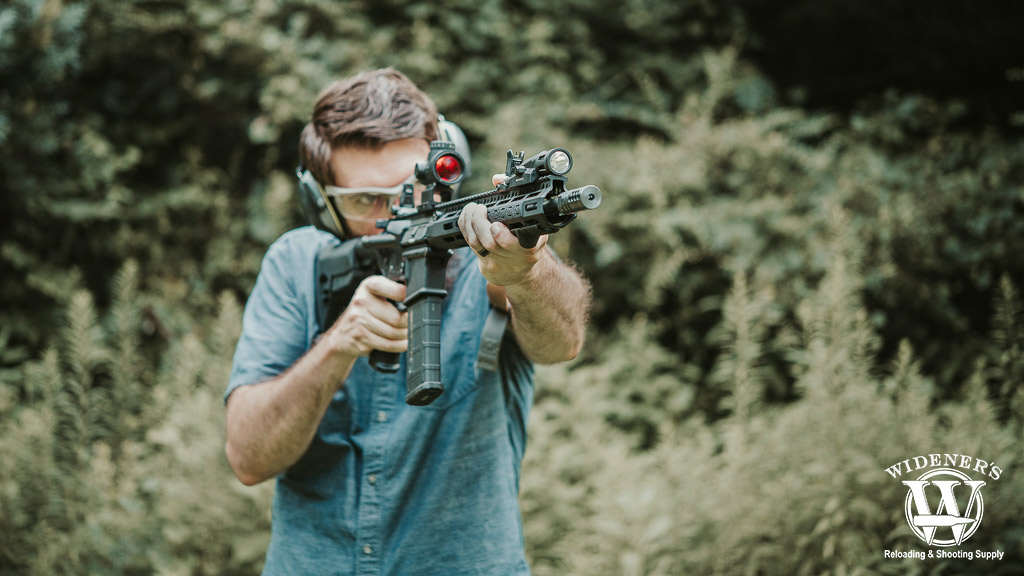
From plinking to hunting, and professional law enforcement applications, the 223 Rem is an adaptable cartridge.
The .223 has proven to be an adaptable, reliable, and versatile caliber. It has a variety of loads ranging from lightning-fast varmint rounds to antelope and deer rounds. The heavy boat-tails make for precision marksmanship and tactical sharpshooting. It is cheap, plentiful, and very useful to have around. You can sleep easy with an AR-15 loaded with dedicated tactical 77gr rounds standing watch. Any landowner is confident he can dispatch all forms of varmints with a healthy dose of .223 Remington.


